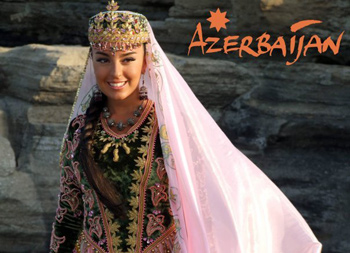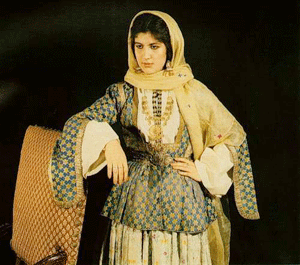Home page
» ART
» Azerbaijan\'s national dress
Azerbaijan\'s national dress
One of the main attributes of the people of Azerbaijan related to its national history and national culture is national clothes. This type is unique because of the artistic features of folk art, its different forms; artistic decorative patterns were reflected in the textile clothes. Men’s and women’s clothes were the same in all ethnic, historical zones. However, clothes of men reflected the class of its owner. Children\'s wear was the same as elder’s dress in form and distinguished only by some of the features and size. Azerbaijan women\'s dress of the XIX century and the beginning of the XX century consisted of the lower and top dresses. The top wear consisted of top shoulder and belt wears. Women\'s top shoulder dress is top shirt dress, back dress and chapkan. The cut of top shirt, its shoulder consisted of seamless, colorful under armpit. These shirts were made of mainly qanovuz and silk cloths. Chapkan – top shoulder is women dress consisting of lining and false sleeves. This dress was sewn from tirma, velvet and few types of silk.  Bahari is in quilted lining top shoulder women dress. It is mainly made of velvet. Kurdu is the top women dress. This clothing was sewn of tirma, velvet, leather and decorated with dense patterns. Eshmek is a female banded overcoat, and sewn of velvet and tirma. The cloth’s collar, sleeves is decorated with safsar fur, decorated with gold net and sharid. In the cities when the women went out of the house they wore the chakhchur over skirt. Men national top wear consisted of chemise, arkhalig, gaba and chukha (top shoulder). One and two sided archalig was sewn of silk, satin, cashmere, cloth, satin. Qaba is the top male dress and sewn mainly of tirma. Chukha is decorated buttonless ship skin made fur coat. This is the analogue of embroidery to the ancient one of people of Azerbaijan. Merchants, travelers and diplomats traveled here in different periods stated a lot of interesting facts on the development of the handicraft. Italian traveler Marco Polo (XIII century) emphasized the beauty of Shamakhi and Barda silk products.  English traveler- merchant Antony Jankinson (XVI century) described the fashion of the summer residence: King was sitting in a rich tent decorated with gold, pearls and precious stones and gems on his clothes. At the end of XIX - early XX century, the cloth used for local production of patterns and embroidery was qanovuz, delicate silk and velvet. Most often the description of bird couples was found – it was the most ancient and famous ornament motive. The birds usually were described either in manner loving each other, or in fighting pose (a symbol of love and separation). And from animals in the pattern embroidery gazelles, turtles, snake-dragon, horses were described. And from household items small jugs for the rose water, comb boxes, glass containers for cosmetics, vessels etc were used in decoration. In Azerbaijan in household life the famous and spread embroideries were: golden embroidery, embroidered with needlework, drum patterns, techniques of birds eye, bright jewelry, embroidery with beads, , sealed scales, koklama (sirma), application, spiral type sewing and work on the file. One of the widely spread embroideries was «birds eye is made of white or colored silk thread. Koklama embroidery is met with at decoration with araqcın, sabkullar (night cap), prayer carpets, woolen clothes. It was made of ordinary and water sewing, and the fine wool or cotton layer is put between the linen and face. Embroidery with beads and pearls causes such a great interest that since the old times the costume elements decorated the household items etc. Emboirdery with bright jewelry is sewing of patterns with colored silk threads on a piece of cloth on painted decorations. Application and spiral embroidery are relatively young methods. In rare cases, work on file and mereyka (lattice pattern) was spread later and its spreading area is not wide. This type of handicraft is characteristic for decoration of paper tissues, towels and veils. And today in many cities of Azerbaijan the ancient schools in embroidery are preserved Hand works of Azerbaijani masters decorate the expositions of the international fair and museum. Among embroideries most ancient of all kinds was gold embroidery. As the basis very strong ffabrics were used. The best material was one color red, cornelian, purple and green-colored velvet. Also, the different tones of fine cloth, a cloth, tirma, satin was sewn in morocco skin. For golden embroidery golden or silver threads are used. This type of embroidery is a named as gulabatyn. Often, the women\'s dress, head wears, household belongings, horse decorations and even small items are decorated with golden embroidery. There was even a tradition that the bride\'s dowry contained golden sewn various items of household purposes. Among colored silk threads embroidery sewing tambur sewing was most spread. In XIX century Sheki was a center of production of tambur sewing. The main role of the tambur sewing belonged to thin local or imported red, black and dark - blue velvet and broadcloth. Complicated and strange (nicely) decoration was sewn with bright silk threads in the dark background. Many of men had demonstrated an unusual skill in the field of applied art. First the master sews the contours of the picture on filled inside of it. Needle for tambur sewing is called as “garmach”. With tambur sewing women’s clothes, faces a big pillow, bath carpets, covers were decorated.
|
